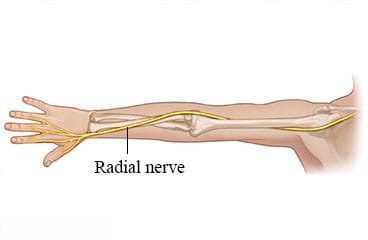Overview
The radial nerve runs down the arm. It controls muscles in the back of the arm. It also helps with movement and feeling in the wrist and hand.
If you injure the back of your arm or pinch the nerve, you might have trouble moving your arm, wrist, or hand. You might also have pain, weakness, numbness, tingling, or trouble lifting your wrist or fingers. This can also happen if you fall asleep in a way that puts pressure on the nerve, such as with your arm hanging over a chair.
In most cases, no treatment is needed. You will slowly get more strength and feeling. This can take weeks or even months. Sometimes physical or occupational therapy is used to keep up muscle strength. You might also need other tests, such as nerve tests or an MRI. If you don't get better, or if the injury is more serious, surgery might be needed to fix the nerve or remove something pressing on it.
Follow-up care is a key part of your treatment and safety. Be sure to make and go to all appointments, and call your doctor if you are having problems. It's also a good idea to know your test results and keep a list of the medicines you take.


